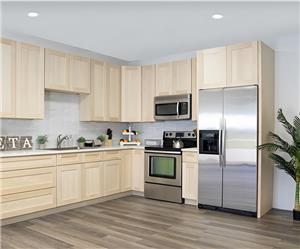Plywood vs MDF vs Particle Board: Difference and Comparison(1)
Are you looking for the right material for your home or kitchen cabinets? In that case, you have several options such as composite wood. This type of material is among the best and most affordable in the market but not many understand their differences. This article is here to help you differentiate composite wood products – plywood, MDF, and particle board.
But first, you may want to know a bit about composite wood. Composite wood is a substitute for real wood, which is made of a mix of wood flour or wood fibers along with plastic materials and binding agents. Why choose composite wood? Well, it is more durable and stronger than traditional wood.
In the early 1980s, the company American Woodstock created the technology behind composite wood. They call it WPC or Wood Plastic Composite. Using this technology, they were able to develop a flat sheet containing polypropylene and wood flour, eventually making automotive paneling. That was the first time composite wood was made.
Composite wood is more eco-friendly since it can be created using waste wood chips or wood pellets. It’s perfect because there are a lot of wood wastes that can be recycled and reproduced. Composite wood also doesn’t need cleaning or varnishing and is also waterproof. With these many benefits, it’s not surprising that it’s a popular material.
What is Particleboard?
Particleboard is a composite wood made from sawmill shavings, wood chips, sometimes even sawdust, plus resin, which are heat pressed together. Chemicals such as dyes, wax, release agents, and wetting agents are then used to make the particleboard insect-proof, fireproof, and/or water-resistant.
Once all the wood scraps, chemicals, and resins are mixed into a liquid, it is then made to become a sheet. The process also involves evenly distributing the wood chips, so that the finished board won’t be too heavy. Wood bits and resin must have the tightest bond, thus the board is compressed several times.
Types of particles boards
There are also different types of particle boards, some of which are:
Oriented strand board (OSB) – the layers of woo strands have specific orientations and are often used for wall and floor bases.
Laminated particleboard – comes with a thin layer of laminates on the particleboard and is widely used in making modular kitchen, shelves, and wardrobes.
Veneered particle board – this particleboard is made by attaching veneer on its top surface, improving its aesthetics at a low cost.
Cement bonded particle board – this one’s bonding agent is cement, which makes it highly resistant to fire, moisture, and rot.
Melamine particle board – this particleboard has a sheet of décor paper full of melamine attached to its top surface, making it extra durable and scratch-resistant.

Quality & Cost
Particleboards are a type of composite wood important for structural purposes. It isn’t as durable as other composite wood products, but it is great for furniture that has to be assembled. In terms of cost, it is more affordable than some plywood. Its price can go as low as $10 to as high as 35$ per sheet.
Advantages of Particle Board
The biggest advantage of particleboard is it is cost-effective compared to other composite wood products. It is also highly decorative with a flat and smooth surface. Particleboards don’t distort or dent easily, which is another plus to being easy to handle and transport because it is lightweight.
Particleboards also have more screw holding capacity, making them an excellent material for assembled furniture. This composite wood is easy to clean and needs only minimal maintenance. One notable feature of particleboards is it has thermos-acoustic insulation properties, so it’s great for speakers and similar uses.
Disadvantages of Particle Board
The biggest disadvantage of particleboards is their low strength compared to other composite wood products. Because it has low density, it can easily sustain damage during transportation. It is also weak against moisture, expanding, warping, and discoloring when exposed.
Particleboards also have low durability, being incapable of supporting heavy loads. Out of all these disadvantages, the most dangerous is the possibility that it is toxic. This is because its manufacturing uses urea-formaldehyde resin, from where formaldehyde gas comes from and is a known carcinogen.




